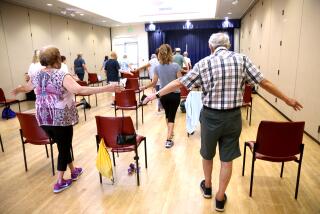Freud’s ‘Ageism’ Disputed; Therapy Aids Older People
- Share via
LA JOLLA — A woman in her 60s was seeking psychiatric help for deep feelings of loneliness that had developed as she wound down from a pretty wild life in her younger years, when she had abandoned her children.
Because of the woman’s age, her chances of being treated with anything more than superficial advice and anti-depressant drugs were slim, because most psychiatrists do not view people older than 50 as candidates for effective analysis.
But in this case, the woman’s therapist did not share the traditional prejudices of his profession. He was willing to consider that older people continue to go through stages of development similar to the well-accepted theory of psychological growth from childhood through young adulthood.
The therapist postulated that the woman was at a point at which grandparenthood would be central to her normal development. So he asked the woman about her children, and he encouraged her to try to get in touch with them, which she did. The children responded positively: Two daughters came from another country to visit and helped their mother toward a dramatically improved outlook on life.
The case is an example of the arguments being made by two San Diego psychiatrists who hope to turn around the traditional slighting of people older than 50 who seek psychiatric therapy.
“She was the kind of patient who most therapists look at and say, ‘Oh, this person can’t do anything, I’ll just tell her the most simple-minded things and give her medication,’ ” said Dr. Robert Nemiroff, a professor who directs the training program for residents in psychiatry at the UC San Diego Medical School.
“Most therapists in a million years would never have thought of the idea to contact the grown women (daughters) in another country,” added Dr. Calvin Colarusso, who heads the child psychiatry training unit for residents at the school.
In their new book, “The Race Against Time,” the two physicians lay out the benefits of sympathetic treatment for older people by citing specific clinical cases. The book follows an earlier literary effort of Nemiroff and Colarusso to define a theory of normal development for the second half of life, paralleling a long-accepted theory for childhood.
“We say that selected patients of any age are suitable candidates for analysis and therapy,” Colarusso said. “Within our profession, the negativism about treating older people stems directly from (Sigmund) Freud’s pessimism that anyone over 40 was essentially too old to benefit.”
Nemiroff explained that Freud’s views were an early manifestation of what the two psychiatrists call “ageism,” which assumes that the mental processes of older people are too rigid and unable to change, that they have too many experiences to talk about during therapy, and that treatment for the elderly would not be cost-effective. The ageism did not grow out of Freud’s work with patients, Nemiroff said.
“We are Freudians and our feeling is that Freud is a great genius who contributed incredibly valuable things both to our science and to civilization,” Nemiroff said. “Freud made great discoveries about the importance of childhood to the life cycle; there is the phrase, ‘The child is the father to the man’ in that childhood determines to a great deal how we are as adults.
“But while that is a magnificent finding, it is not the whole, and the field (of psychiatry) has gotten stuck on this. On the score of (older people being not treatable), Freud was just wrong.”
The initial work of Nemiroff and Colarusso grew in part out of their own experiences in moving to California from the East Coast when both were 35 years old.
“They proved important individual and family experiences for both of us, independently, and we experienced a lot of change and growth from moving West,” Nemiroff said. “So we were able to say to ourselves, we were not fixed or rigid, as a result of our own mid-life transition.”
In addition, their own success in treating older patients convinced them that they should expand on developmental theory for adults. They discovered that the concept exists in written works of every major civilization--in early Greek writings, in Confucianism, in early Japanese spiritualism--that every culture has a defined description of a life cycle, of what a man or woman should do at each age.
Because of several hypotheses they made, the two authors have encountered some resistance to their findings.
“We stress two universal hypotheses about adulthood: the importance of the decline of the body in the second half of life; and the increasing awareness that our time is limited and we are going to die,” Colarusso said. “Both of these experiences are enormously powerful in organizing what happens normally in our mental development during the second half of life, not only for a patient but for the therapist as well.
“Therapists must face and deal with these topics themselves in treating older people, and we think there is an unconscious resistance on their part to doing so.”
In carrying their theory into treatment, Colarusso said that psychiatrists must discard the myths that older people are asexual and unable to change. “We found particularly that they are not in the least asexual mentally or, if a partner is available, physically,” he said.
Nemiroff criticized traditional clinical practice that treats mid-life changes as existential; that is, the problems being faced are those that everyone goes through and therefore not so important.
“We’re saying that the situations faced by some people in mid life are true crises, are times of enormous change and can be real problems for the people,” Nemiroff said. “For example, when there is a divorce after many years, it can be of momentous import in that a spouse may see it as the death of a family.”
The mid-life crisis can include fears of diminution of sexual potency, or a fear of being replaced on the job, or a realization that a person is never going to accomplish all the goals he or she set earlier in life.
Nemiroff told of a 45-year-old male accountant who injured his leg jogging and then began to experience occasional impotence. “He developed concerns about his body, devising a plan to leave his wife and change his profession all at the same time,” Nemiroff said.
During treatment, the man was able to understand that he was “looking for the fountain of youth” as a way of handling his fears of growing old and going to pieces, Nemiroff said. By gaining such perspective, the man no longer needed to revert to disastrous choices “he would end up paying a tremendous price for,” Nemiroff said.
“All of this revolves around what we called the universal truths: the fear of getting old and dying,” Colarusso said. “What follows in a preventive way is that people should understand that time is limited and valuable, and that they should want to enrich their lives as much as they can.
“For example, I know how important my wife and children are to me, and while my kids see us taking care of our parents now, I know someday I will need them to take care of me. That makes me recognize how valuable relationships are and helps me order my life to deal with such issues.
“But what can happen pathologically is that people get scared and say, ‘Gee, I’m running out of time, I’d better get a divorce, et cetera.’ They end up making a lot of desperate attempts to construct something new and that usually doesn’t work.”
Nemiroff added: “That is where the title of our book comes in. And within the limited time, you have enormous choices to act upon, especially if you have the perspective on life that allows you to make the choices.”
Both psychiatrists said more and more of their colleagues around the country share their views on treating older patients with more than just medication or suggestions.
“We teach regularly through our residents (students), we speak at conferences, and word gets around through our books,” Nemiroff said. Since many physicians are in a position to refer patients to psychiatrists, Nemiroff said that doctors must be stripped of their suspicion that exploring and treating the mind through talk is not as legitimate as treating it with medication.
Nemiroff and Colarusso are writing a third book intended for the public. “More and more, the demographics show an aging population--more than half the population is more than 30--and attention will more and more focus on the older persons,” Colarusso said.
More to Read
Sign up for our Book Club newsletter
Get the latest news, events and more from the Los Angeles Times Book Club, and help us get L.A. reading and talking.
You may occasionally receive promotional content from the Los Angeles Times.








